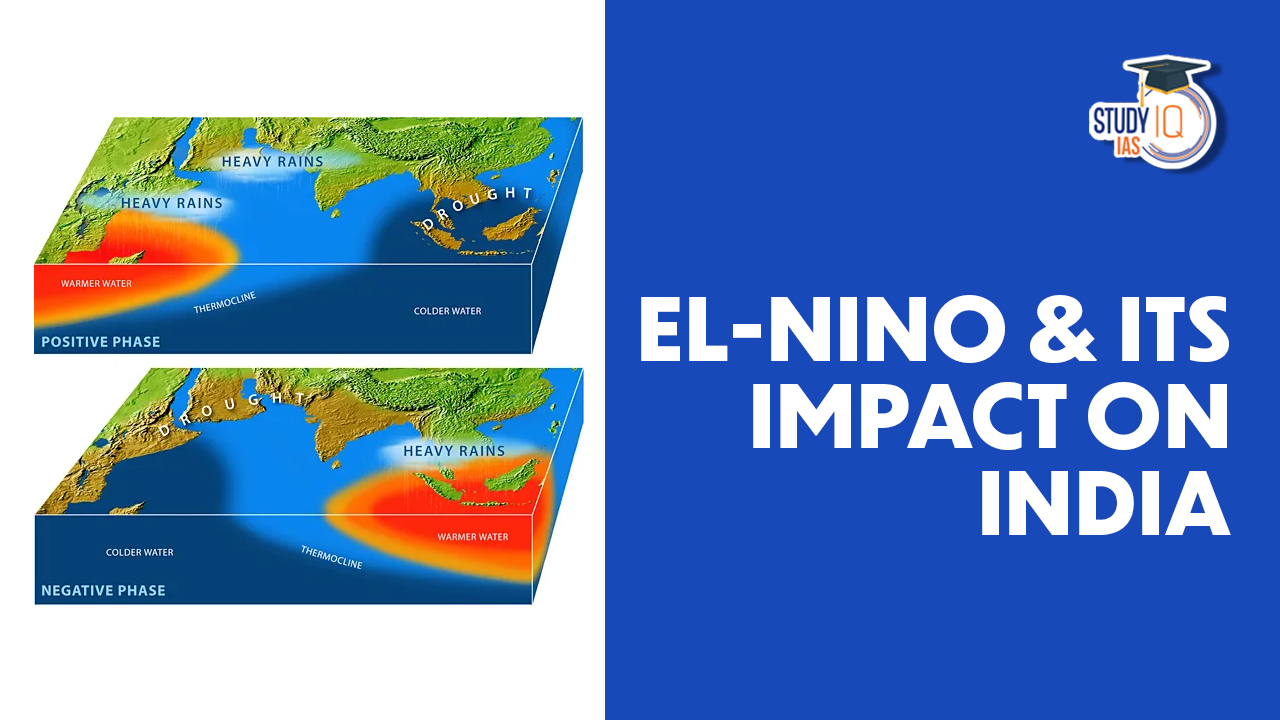Table of Contents
Context: Most climate models are indicating high probabilities for El Niño developing by July-August.
About El-Nino
- El Nino is a Spanish word that means ‘The Little Boy’.
- The occasional climatic change and development of warm ocean surface waters along the coast of Peru and Ecuador are called El Nino effect.
- Mechanism: In El Nino, the trade winds which blow along the Equator from east to west weakens and creates high air pressure in the Western Pacific Ocean and low air pressure in the eastern Pacific Ocean.
- Due to this, the surface water moves towards the coast of northern South America.
- The central and east Pacific ocean warms up for six months, creating an El Nino effect.
- During El Nino, warming of the central and east pacific oceans reduces the usual upwelling of cold water, ultimately reducing the nutrient content in that region.

Impact of El-Nino on India
- Weak Monsoon for India: Monsoon is significant for the overall economy because it accounts for 70 percent of annual rainfall in a country where about half of the farmlands depend on annual showers for irrigation.
- Agriculture employs more than half of the workforce in India and makes up about 18 percent of India’s economic output.
- Agrarian economy: El Nino directly impacts India’s agrarian economy as it tends to lower the production of summer crops such as rice, sugarcane, cotton, and oilseeds.
- Impact on Rural Income: Any disruption in domestic agricultural production could result in lower income for rural households as about 60 percent of the rural population is still employed in the farm sector.
- Crop Yield: In some parts of India, the failure of the monsoons result in water shortages, resulting in below-average crop yields.
- Farming Distress: A lot of Farmers commit suicide because they are not able to repay the loan they had taken for growing the crop.
- Indian Agriculture Import: India imports agricultural products from many countries. If these source countries experience El- Nino related drought, prices of agricultural produce may go up.
- Prices of crops such as sugarcane, rice, coffee, wheat, etc, that are grown in large quantities in South Asia and South East Asia are expected to go up.
- Inflation: Shortages in food supply then result in spike in food prices all across the country pushing inflation up.
- Tighter Monetary Policy: High food inflation pushes the RBI and the government to adopt a more cautious approach to monetary and fiscal policy respectively. A tighter monetary policy may affect the economic growth rate of the nation.
- Power Generation: Weak monsoons also result in lesser power generation from hydro power dams thus leading to lesser electricity for industries.
- Drought: Ten of last 15 droughts were led by El Nino events. If the drought is severe, it would dry up major sources of fresh water leading to a water crisis like situation.
Way Forward
- Early warning systems: Governments can establish early warning systems that can alert people to the possibility of El Niño and its potential impacts.
- The early warning systems can include regular weather forecasts, alerts via radio and television, and other communication channels.
- Water conservation: Governments and individuals can take measures to conserve water, such as reducing water consumption and harvesting rainwater.
- These measures can help to reduce the impact of water shortages and ensure that there is enough water for essential uses, such as drinking and agriculture.
- Disaster preparedness: Governments can develop disaster preparedness plans that can help people to cope with the impacts of El Niño.
- This can involve measures such as providing emergency food and water supplies and setting up evacuation centers for people who are displaced by floods or other climate-related disasters.
Conclusion
- El Niño is a complex and fascinating climate phenomenon that can have far-reaching effects on weather patterns around the world.
- By understanding the causes and effects of El Niño, we can better predict and prepare for its impacts, and work to mitigate the risks associated with this natural phenomenon.


 Daily Quiz 01 July 2025
Daily Quiz 01 July 2025
 China, Pakistan and Bangladesh Trilatera...
China, Pakistan and Bangladesh Trilatera...
 US Pulls Funding from GAVI-Global Vaccin...
US Pulls Funding from GAVI-Global Vaccin...





















